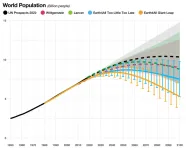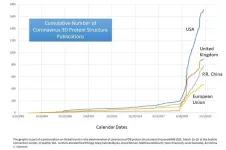(Press-News.org) Statement Highlights:
As health care professionals, researchers and consumers increasingly use genetic testing, they are uncovering incidental genetic abnormalities, or variants, that are associated with cardiovascular diseases.
The statement writing committee cautions that incidentally identified single gene variants may or may not be risk factors for disease, so it is important to interpret them correctly and cautiously.
The new scientific statement offers a framework to support health care professionals in appropriately assessing individual genetic variants, communicating findings with patients and families, and, when needed, how to create a strong multidisciplinary team for individualized care.
Embargoed until 4 a.m. CT / 5 a.m. ET Monday, March 27, 2023
DALLAS, March 27, 2023 — Increasing use of genetic testing means people may discover they have a gene variant associated with some types of cardiovascular disease (CVD). A new scientific statement, published today in the American Heart Association journal Circulation: Genomic and Precision Medicine, aims to help individuals and health care professionals understand what to do when a variant is discovered.
An American Heart Association scientific statement is an expert analysis of current research and may inform future guidelines. The new statement, “Interpreting Incidentally Identified Variants in Genes Associated with Heritable Cardiovascular Disease,” suggests next steps to determine whether a variant truly carries a health risk, provides support to health care professionals on how to communicate with people and their families, and suggests appropriate follow-up actions to care for people with variants deemed higher risk for CVD.
Variants associated with cardiovascular disease risk are often found “incidentally” when people undergo genetic testing for non-cardiac reasons, including screening or diagnosis of other diseases. These unexpected genetic variants may also be discovered with genetic testing through direct-to-consumer DNA testing kits.
Pretest genetic counseling is strongly encouraged to prepare patients for the possibility of incidental findings, how and whether findings will be communicated, and potential implications for themselves and family members.
“The scope and use of genetic testing have expanded greatly in the past decade with the increasing ease and reduced cost of DNA sequencing,” said Andrew P. Landstrom, M.D., Ph.D., FAHA, chair of the scientific statement writing committee and associate professor of pediatrics and cell biology at Duke University School of Medicine in Durham, North Carolina. “Where we would once look for genetic changes in a handful of genes, we can now sequence every gene and, potentially, the whole genome, allowing us to make genetic diagnoses that would have been impossible in the past. However, with increased genetic testing comes more surprises, including finding unexpected variants in genes that might be associated with cardiovascular disease.
“If we interpret these incidental variants incorrectly, it may lead to inappropriate care, either by suggesting patients have a risk of cardiac disease when they do not, or by not providing care to those with increased risk for a serious condition.”
This statement is the first to focus on inherited monogenic, or single-gene, diseases for CVD which can be passed on within families, such as hypertrophic cardiomyopathy or long QT syndrome. There are currently 42 clinically treatable, secondary variant genes that increase the risk of sickness or death from sudden cardiac death, heart failure and other types of cardiovascular disease, according to the American College of Medical Genetics and Genomics. Genetic variants that cause long QT syndrome cause the heart to electrically reset slower than normal after each contraction, which may cause electrical instability of the heart and may lead to fainting, arrhythmias or even sudden death.
Once an incidental genetic variant for CVD is found, the statement authors suggest a framework for interpreting the variant and determining whether it is classified as benign, uncertain or pathogenic (disease-causing):
Health care professionals should only relay information to patients about incidentally identified variants if they are among the cardiovascular disease genes already known to be associated with CVD and if patients agreed during pretest genetic counseling to be informed about incidental findings.
Incidentally identified variants in genes with an uncertain association with CVD should not be reported.
If the discovered variant may increase the risk of CVD, a family history and medical evaluation by an expert health care professional are suggested, preferably a specialist working with or within a multidisciplinary team to address in the disease in question. The goal of this evaluation is to determine whether the individual has evidence of the disease, such as symptoms or relevant test results, or if there are any warning signs in the family history.
The genetic variant itself should be re-evaluated periodically by an expert or expert team to ensure whether the CVD link remains accurate. As knowledge about a variant evolves over time, its link to disease may be reclassified.
Finally, the medical evaluation and genetic re-evaluation should guide next steps, which may vary from dismissing the incidental variant as not likely to cause CVD to starting medical interventions. This may also involve periodic re-evaluation with appropriate tests (echocardiogram, blood tests, etc.) and possibly screening other family members for the variant.
“The list of incidental variants related to cardiovascular disease continues to evolve. This statement provides a foundation of care that may help people with a CVD-related genetic variant and their health care professionals take the next step in determining the individual and familial risk that a variant may or may not carry,” Landstrom said. “It’s also important to consult with genetics specialists to custom-tailor an evaluation and treatment plan to both the individual and the genetic variant in order to ensure the highest level of care possible.”
This scientific statement was prepared by the volunteer writing group on behalf of the American Heart Association’s Data Science and Precision Medicine Committee of the Council on Genomic and Precision Medicine and the Council on Clinical Cardiology; the Council on Cardiovascular and Stroke Nursing; the Council on Hypertension; the Council on Lifelong Congenital Heart Disease and Heart Health in the Young: Council on Peripheral Vascular Disease; and the Stroke Council. American Heart Association scientific statements promote greater awareness about cardiovascular diseases and stroke issues and help facilitate informed health care decisions. Scientific statements outline what is currently known about a topic and what areas need additional research. While scientific statements inform the development of guidelines, they do not make treatment recommendations. American Heart Association guidelines provide the Association’s official clinical practice recommendations.
Co-authors are Anwar A. Chahal, M.B.Ch.B., Ph.D., M.R.C.P., vice chair; Michael J. Ackerman, M.D., Ph.D.; Sharon Cresci, M.D.; Dianna M. MIlewicz, M.D., Ph.D.; Alanna A. Morris, M.D., M.S., FAHA; Georgia Sarquella-Brugada, M.D., Ph.D.; Christopher Semsarian, M.B.B.S., Ph.D., M.P.H., FAHA; Svati H. Shah, M.D., M.H.S., FAHA; and Amy C. Sturm, M.S., L.C.G.C. Authors’ disclosures are listed in the manuscript.
The Association receives funding primarily from individuals. Foundations and corporations (including pharmaceutical, device manufacturers and other companies) also make donations and fund specific Association programs and events. The Association has strict policies to prevent these relationships from influencing the science content. Revenues from pharmaceutical and biotech companies, device manufacturers and health insurance providers, and the Association’s overall financial information are available here.
Additional Resources:
Available multimedia is on the right column of release link https://newsroom.heart.org/news/genetic-tests-unexpectedly-find-genes-linked-to-heart-disease-now-what?preview=6a9e460519e79daf4881f058ba2f0819
After March 27, view the manuscript online.
AHA research profile: Long QT syndrome - Brian P. Delisle, Ph.D.
AHA news releases:
Health screening, genetic tests might identify people at risk of premature heart disease (May 2022)
Gene map may help identify heart disease risk for people with Type 2 diabetes (April 2022)
AHA Scientific Statements:
New statement provides path to include ethnicity, ancestry, race in genomic research (July 2021)
Genetic testing for heart diseases may help patients and families identify risks (July 2020)
Follow AHA/ASA news on Twitter @HeartNews
About the American Heart Association
The American Heart Association is a relentless force for a world of longer, healthier lives. We are dedicated to ensuring equitable health in all communities. Through collaboration with numerous organizations, and powered by millions of volunteers, we fund innovative research, advocate for the public’s health and share lifesaving resources. The Dallas-based organization has been a leading source of health information for nearly a century. Connect with us on heart.org, Facebook, Twitter or by calling 1-800-AHA-USA1.
###
END
Genetic tests unexpectedly find genes linked to heart disease — now what?
A new American Heart Association scientific statement helps interpret incidentally found gene variants that may be associated with cardiovascular disease risk
2023-03-27
ELSE PRESS RELEASES FROM THIS DATE:
Biochar and energy from pyrolysis can pave the way for carbon-neutral agriculture in China
2023-03-27
Since the Paris Agreement to combat global warming was reached in 2015, many countries have committed to becoming climate neutral, i.e., achieving net-zero greenhouse gas emissions. The world's largest agricultural country, China, is also committed to join the green transition. As the largest agricultural country, China is also the world's biggest emitter of greenhouse gases, yet it has set itself a target of achieving carbon neutrality by 2060.
According to Professor and Head of Land-CRAFT at Department of Agroecology at Aarhus University Klaus Butterbach-Bahl, this places huge demands on agricultural systems: "Agriculture in China accounts ...
Two striking new species of carnivorous plants discovered in the Andes of Ecuador
2023-03-27
A team of botanists from Ecuador, Germany, and the United States has described two new species of carnivorous plants with striking appearance. They are part of the butterworts (genus Pinguicula), a group of flowering plants with about 115 species that can catch and digest small insects with their sticky leaves. Whereas the majority of butterwort species is distributed in the northern hemisphere, these new species were discovered in the high Andes of southern Ecuador, close to the border with Peru.
Carnivorous plants use animals (usually small insects) as an additional source of nutrients ...
Global population could peak below 9 billion in 2050s
2023-03-27
The new projection is significantly lower than several prominent population estimates, including those of the United Nations. The researchers go further to say that if the world takes a “Giant Leap” in investment in economic development, education and health then global population could peak at 8.5 billion people by the middle of the century.
The new projections by researchers from the Earth4All initiative for the Global Challenges Foundation is published as a working paper People and Planet, 21st Century Sustainable Population Scenarios and Possible Living Standards Within Planetary Boundaries.
The team used a new system ...
Looking from different perspectives! Proper electronic structure of near-infrared absorbing functional dyes discovered
2023-03-27
Near-infrared light, whose wavelength is longer than visible light, is invisible and can pass through many substances. Organic materials that efficiently absorb near-infrared light are essential for technological innovations that utilize near-infrared light, such as the dyes in the infrared blocking filters of smartphone cameras and security inks. These and many more technical applications make developing new dyes that can absorb longer wavelengths of near-infrared light desirable.
Previously, near-infrared absorbing organic materials were treated as closed-shell molecules without unpaired electrons. However, a joint research group led by Associate Professor Takeshi Maeda, Assistant Professor ...
Bodies of people with mental illness are biologically older than their actual age
2023-03-27
New research shows that people with a lifetime history of mental disorders such as depression, bipolar disorder, or anxiety disorders have blood markers suggesting that they are older than their actual age. This may go some way to explaining why people with mental health problems tend to have shorter lifespans and more age-related diseases than the general population.
Dr Julian Mutz and Prof Cathryn Lewis, from King’s College London, looked at data on 168 different blood metabolites from 110,780 participants in the UK Biobank2. They linked these data to information on whether individuals had a history of mental illness and found that those with a mental illness ...
Study identifies two promising molecular targets for drug development in recurrent and metastatic cervical cancer
2023-03-27
NRG Oncology GOG-0240 is the phase 3 randomized trial which demonstrated that the incorporation of bevacizumab with chemotherapy resulted in a statistically significant and clinically meaningful survival benefit for women with recurrent and metastatic cervical carcinoma (NCT00803062). GOG-0240 was a proof of concept in anti-angiogenesis therapy and a proof of principle in supportive care and led directly to an indication for bevacizumab in this disease in over 60 countries. Whole genome sequencing and whole exome sequencing of tumor samples obtained in GOG-0240 suggest that ARID1A and PIK3CA could represent potential targets ...
'Nano inks' could passively control temperature in buildings, cars
2023-03-27
World-first ‘phase change inks’ that could transform how we heat and cool buildings, homes and cars – to achieve sophisticated ‘passive climate’ control – have been developed, with enormous potential to help reduce energy use and global greenhouse gas emissions.
New research published in The Royal Society of Chemistry’s Journal of Materials Chemistry A led by Dr Mohammad Taha, documents proof-of-concept ‘phase change inks’ that use nanotechnology to control temperature in everyday environments. They achieve this by adjusting the amount of radiation that can pass through ...
Project helps thousands of people in England and France into employment and entrepreneurship
2023-03-27
New research led by the University of East Anglia (UEA) shows that large infrastructure projects which are the focus of the UK government’s levelling up agenda and include support for business start-ups, must also offer sustainable, local investment in deprived communities.
Through place-based micro-enterprise training and employment support over a longer time frame, lasting local impact can be demonstrated, according to the study’s policy recommendations.
Supporting people to return to their communities, increasing social cohesion within them, boosting digital literacy and enabling net zero jobs are also likely to play a role.
These goals can be easily ...
Embryos’ development is delayed in pregnancies that end in miscarriage
2023-03-27
Embryos in pregnancies that end in miscarriage take longer to develop in the womb than those in pregnancies that result in live births, according to new research published today (Monday) in Human Reproduction [1], one of the world’s leading reproductive medicine journals.
For the first time, researchers in The Netherlands have been able to look at the way embryos develop while pregnancies are ongoing. They used state-of-the-art imaging technology, including 3D ultrasound with high resolution transvaginal probes and ...
Global analysis of coronavirus protein research reveals how countries respond to disease
2023-03-27
In a new study, researchers examined how a country’s number of published 3D protein structures for coronaviruses, including the one responsible for COVID-19, correlated with its economic output and population. The findings reveal important insights into how different countries' research establishments respond to disease outbreaks and could be useful for planning responses to future pandemics.
The study showed that countries with larger economies generated more 3D structure determinations for the protein components ...
LAST 30 PRESS RELEASES:
Air pollution exposure and birth weight
Obstructive sleep apnea risk and mental health conditions among older adults
How talking slows eye movements behind the wheel
The Ceramic Society of Japan’s Oxoate Ceramics Research Association launches new international book project
Heart-brain connection: international study reveals the role of the vagus nerve in keeping the heart young
Researchers identify Rb1 as a predictive biomarker for a new therapeutic strategy in some breast cancers
Survey reveals ethical gaps slowing AI adoption in pediatric surgery
Stimulant ADHD medications work differently than thought
AI overestimates how smart people are, according to HSE economists
HSE researchers create genome-wide map of quadruplexes
Scientists boost cell "powerhouses" to burn more calories
Automatic label checking: The missing step in making reliable medical AI
Low daily alcohol intake linked to 50% heightened mouth cancer risk in India
American Meteorological Society announces Rick Spinrad as 2026 President-Elect
Biomass-based carbon capture spotlighted in newly released global climate webinar recording
Illuminating invisible nano pollutants: advanced bioimaging tracks the full journey of emerging nanoscale contaminants in living systems
How does age affect recovery from spinal cord injury?
Novel AI tool offers prognosis for patients with head and neck cancer
Fathers’ microplastic exposure tied to their children’s metabolic problems
Research validates laboratory model for studying high-grade serous ovarian cancer
SIR 2026 delivers transformative breakthroughs in minimally invasive medicine to improve patient care
Stem Cell Reports most downloaded papers of 2025 highlight the breadth and impact of stem cell research
Oxford-led study estimates NHS spends around 3% of its primary and secondary care budget on the health impacts of heat and cold in England
A researcher’s long quest leads to a smart composite breakthrough
Urban wild bees act as “microbial sensors” of city health.
New study finds where you live affects recovery after a hip fracture
Forecasting the impact of fully automated vehicle adoption on US road traffic injuries
Alcohol-related hospitalizations from 2016 to 2022
Semaglutide and hospitalizations in patients with obesity and established cardiovascular disease
Researchers ‘listen in’ to embryo-mother interactions during implantation using a culture system replicating the womb lining
[Press-News.org] Genetic tests unexpectedly find genes linked to heart disease — now what?A new American Heart Association scientific statement helps interpret incidentally found gene variants that may be associated with cardiovascular disease risk





